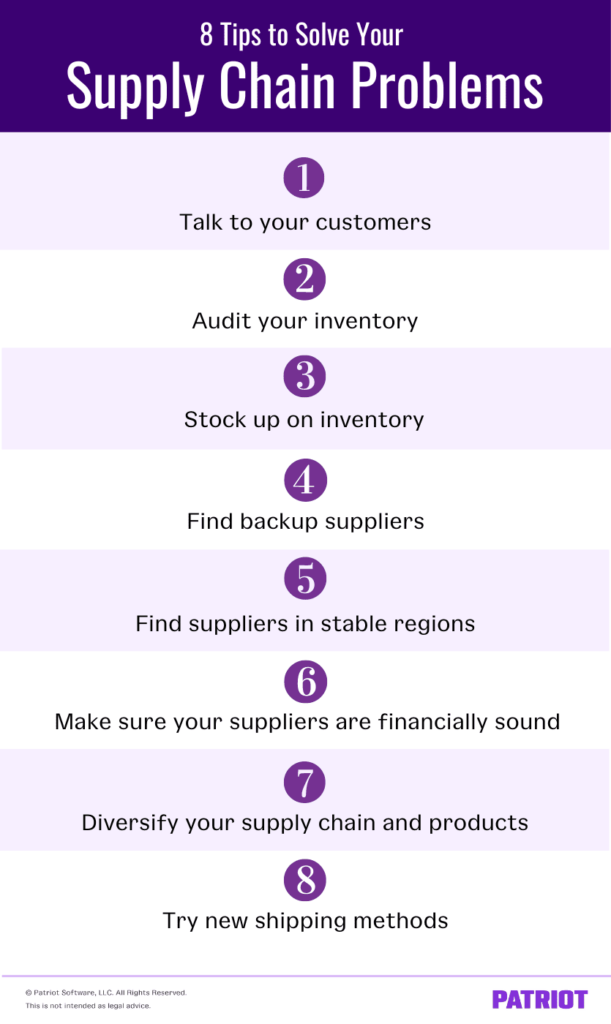First it was COVID shutdowns. Then it was the Ever Green wedged in the Suez Canal (remember that?). Now, it’s a national shortage of truck drivers, warehouse space, and shipping containers … and it’s impacting businesses nationwide. Close to 96% of small business owners report that supply chain disruptions have impacted their business. Has it affected yours? If so, read on to learn how to solve supply chain problems and plan for future disruptions.
How to solve supply chain problems: 8 tips
Supply chain shortages have plagued small businesses across the USA since 2020. That’s a long time to worry about where products are, whether or not they’ll reach your store in time, or whether they’ll get there at all. As we all know, our supply chain blues aren’t over yet. In the second quarter of 2022, 56% of small business owners said that they experienced supply chain shortages.
Supply chain shortages can also help prolong inflation and frustrate loyal customers. But, it isn’t all bad news. Like any good American story, hardships only lead to new possibilities.
Are you dealing with supply chain shortages in your business? Don’t worry. Here are eight tips to help.

1. Talk to your customers
This might sound too simple to be true, but open communication with your customers can go a long way. Being transparent with your customers doesn’t mean that you need to post large posters with the words “Inventory low due to circumstances outside of my control” all over your storefront. Be smart. Your customers will appreciate your honesty.
If you know that particular items currently in stock will be difficult to get a hold of, let your customers know. In store, this can look like a call to action: “Buy now, before it’s out of stock!” Online, let customers know how many items are still available. You can even remind customers about any items left in their cart for a long period.
And, always remember to keep customers up to date on tracking information. Supply chain shortages are frustrating for everyone, but a little bit of information can go a long way.
2. Get to know your inventory
It might not be the most fun thing to do right now, but consider auditing your inventory. Supply chain shortages don’t just make it hard to get a hold of products. They can also impact your bottom line. How? If you run out of products or raise prices, customers may start to look around for better options.
If you know exactly what you have in-store, you can have a better understanding of what your customers, and consumers in general, need. This can also help you come up with new merchandising strategies in your store.
With that knowledge, you can pick up new customers and improve the sales of the products you do have in stock.
3. Stock up
Supply chain shortages don’t affect the world evenly. Some items may seem impossible to get a hold of one week but easy to find in a week or two. And, things can turn around quickly. That item that was impossible to get a hold of? Now it’s everywhere. That dependable, stand-by item? Nowhere to be found.
So, stock up while you can. Don’t go on a spending spree and buy things just because they’re available. Buy the things you know you’ll be able to sell and that won’t lose their value if they have to sit on a shelf for a while. This may mean you have to improve your storage methods to accommodate your additional products.
4. Don’t forget about backup suppliers
Chances are, you have a few suppliers you trust. You’ve used them for years, and you’re happy with them. But, now’s the time to look around and see what else is out there.
The key word here is backup—this doesn’t mean that you are replacing the tried and true suppliers you already have relationships with. This only means that you are planning for the worst. With that in mind, don’t restrict yourself to a specific area. Look around, and don’t worry about finding suppliers that may be farther away than you’re used to. The more options you have now, the more you’ll have when you need them.
Reach out and get to know them. You may need them sooner than later.
5. Find suppliers in stable regions
Political upheaval and climate-related disasters affect supply chains all the time. Just think of recent flooding or wildfires in the U.S. and you’ll get just a glimpse of the complications. Try to find suppliers in regions outside of political and climate hot zones.
Here’s an example: Imagine having a trusted supplier or manufacturer on the Gulf Coast. At the end of summer, each hurricane makes their business more complicated. There’s a chance that a large enough hurricane could close down their operations (at least until the flood water recedes). A backup supplier could help avoid supply chain shortages in this situation.
6. Make sure your suppliers are financially sound
Don’t worry—this isn’t too personal a question. The financial health of your supplier matters, especially during times of inflation and supply chain shortages.
Ask for credit references. Hesitation from your supplier could be bad news.
7. Diversify your supply chain and products
If you depend on only one supplier for an in-demand item, you may want to think of branching out to new suppliers. This is different from finding backup suppliers, although those backup suppliers may be just what you need for short-term solutions.
For long-term solutions, think about rotating your backup suppliers into your dependable roster of suppliers. This might mean that you offer similar products that are made from different brands. One week it’s brand X and another week it’s brand Z.
Diversifying your supply chain and what you offer can help you avoid empty shelves.
8. Try new shipping methods
Now’s the time to try out new shipping methods, like dropshipping, to fulfill customer orders.
Dropshipping is a form of shipping that cuts you out of the picture. A customer places an order, you notify your supplier or manufacturer, and they ship directly to your customer. Dropshipping is a great way to reduce shipping times, especially if you can find manufacturers and suppliers close to your customers.
Dropshipping comes with unique problems. For instance, you may have a hard time keeping track of what is available and a customer may purchase something that is already out of stock. In that case, you’ll have to work overtime to keep your customers happy.
Looking for a better way to handle your accounting needs? Sign up for Patriot Software today to get a free trial of our accounting software. We’ve designed our software with our customers in mind (you’ll see what we mean when you give us a try!).
This is not intended as legal advice; for more information, please click here.



